|
|
|
Sort Order |
|
|
|
Items / Page
|
|
|
|
|
|
|
| Srl | Item |
| 1 |
ID:
110184


|
|
|
|
|
| Publication |
2012.
|
| Summary/Abstract |
This article estimates the effect of armed conflict exposure on school drop-out and labor decisions of Colombian children between the ages of 6 and 17. The empirical strategy is based on two-stage duration analysis and biprobit estimations that take into account the endogeneity of conflict. We find that conflict affects children older than 11, inducing them to drop out of school and enter the labor market too early. We find that short-term exposure to violence is the most relevant for these decisions and probable channels of transmission include higher mortality risks, negative economic shocks, and lesser school quality.
|
|
|
|
|
|
|
|
|
|
|
|
|
|
|
|
| 2 |
ID:
161878
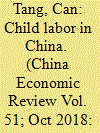

|
|
|
|
|
| Summary/Abstract |
We present the first systematic study on child labor in China. Child labor is not a negligible social phenomenon in China; about 7.74% of children aged from 10 to 15 were working in 2010, and they worked for 6.75 h per day on average, and spent 6.42 h less per day on study than other children. About 90% of child laborers were still in school and combined economic activity with schooling. Our results show that child labor participation is positively associated with school dropout rate. A child living in a rural area is more likely to work. Compared with place of residence, the gender of a child are less important. The educational level of the household head and its interaction with the gender of the household head seem to be unimportant. However, household assets per capita and household involvement in non-agricultural activities are negatively related to the incidence of child labor. A child from a household with more adults is less likely to work. The prevalence of child labor in China exhibits significant regional variations. The child labor incidence is correlated with the development level of each region: the Western region has the highest percentage of child labor, followed by the Eastern and Central regions.
|
|
|
|
|
|
|
|
|
|
|
|
|
|
|
|
| 3 |
ID:
106650


|
|
|
|
|
| Publication |
2011.
|
| Summary/Abstract |
Drawing on the relevant literature, this article explores key debates and controversies on child labour in the context of Africa and Asia. It first identifies and analyses three dominant discourses on child labour: 1) the work-free childhoods perspective; 2) the socio-cultural perspective; and 3) the political economy perspective. Against the backdrop of these discourses, the article goes on to critically examine aspects of child labour that are underrepresented in the literature and in international policy circles. It concludes by highlighting the importance of grounding children's gendered work within the complex material social practices of interconnected histories and geographies in which their livelihoods unfold.
|
|
|
|
|
|
|
|
|
|
|
|
|
|
|
|
| 4 |
ID:
124498
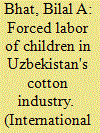

|
|
|
|
|
| Publication |
2013.
|
| Summary/Abstract |
Lack of skilled manpower, sophisticated technology and marketization are a new basis for child labor in central Asia, particularly in Uzbekistan. Agriculture , which comprises 40 percent of GDP of Uzbekistan, has present GDP of Uzbekistan, has turned backwards from the Soviet period when refined technology was provided when refined technology was provided by Russias.
|
|
|
|
|
|
|
|
|
|
|
|
|
|
|
|
| 5 |
ID:
119705
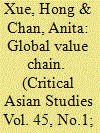

|
|
|
|
|
| Publication |
2013.
|
| Summary/Abstract |
The global value chain concept has become one of the most influential frameworks used in the study of globalization. The paradigm, however, is deficient in explicating the exploitative nature of global value chain governance. Based on a study of soccer ball production in China and Pakistan, this article analyzes global production from three perspectives: the role of the state in shaping the host countries' mode of production and legal framework, the issue of how surplus value is created and distributed, and the use of child labor or prison labor to remain competitive in the chain. The article shows, in the case of Pakistan, how a country using a lower-labor-costs strategy to retain a place in a global value chain allows its workers to be exploited and pauperizes its people.
|
|
|
|
|
|
|
|
|
|
|
|
|
|
|
|
| 6 |
ID:
137248
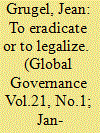

|
|
|
|
|
| Summary/Abstract |
International human rights agreements promote rights-based norms as a guide for policymaking. But the appropriateness and legitimacy of these norms is sometimes questioned in local contexts, where they can generate disagreement as to their meaning and implementation. Convention 182 of the International Labour Organization (ILO) led to a global commitment to eliminate the worst forms of child labor, but the agreement has been subject to intense criticism, especially in societies where child labor is prevalent such as Bolivia. This article sheds light on the complex impact of global rights-based norms in local contexts and reminds us that civil society is always a heterogeneous and political space of action. This article also traces the complex debate on eradication versus legalization of child labor within Bolivia.
|
|
|
|
|
|
|
|
|
|
|
|
|
|
|
|
| 7 |
ID:
182720
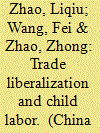

|
|
|
|
|
| Summary/Abstract |
This paper exploits a quasi-natural experiment – the U.S. granting of Permanent Normal Trade Relations (PNTR) to China after China's accession to the World Trade Organization – to examine whether trade liberalization affects the incidence of child labor. PNTR permanently set U.S. duties on Chinese imports at low Normal Trade Relations (NTR) levels and removed the uncertainty associated with annual renewals of China's NTR status. We find that the PNTR was significantly associated with the rising incidence of child labor in China. A one percentage point reduction in expected export tariffs raises the odds of child labor by a 1.2 percentage point. The effects are greater for girls, older children, rural children, and children with less-educated parents. The effect of trade liberalization on the incidence of child labor, however, tends to weaken in the long run, probably because trade liberalization can induce exporters to upgrade technology and thus have less demand for unskilled workers.
|
|
|
|
|
|
|
|
|
|
|
|
|
|
|
|
|
|
|
|
|